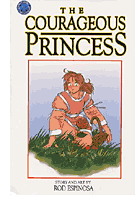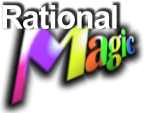

| The Courageous Princess. By Rod Espinosa. San Antonio, TX: Antarctic Press, 2000. 1v. (unpaged). $11.95. Publisher address: 7272 Wurzbach Suite 204, San Antonio, TX 78240. |

|
GENRES: AUDIENCE: SYNOPSIS: Back home, Mabelrose sits in the garden, wondering how she can get a prince to pay attention to her. Suddenly the wind comes up, storm clouds appear, and she falls asleep and is carried off by a sinister figure. As Jeryk grimly sets off in search of his daughter, Mabelrose awakens in a beautiful room in a huge castle. Then, invisible beings lead her to a giant room filled with treasure and presided over by an immense dragon, Shalathrumnostrium. "Oh please, don't eat me! I won't taste good!" Mabelrose cries. But the dragon explains that he has no intention of eating her; he collects princesses, largely in hopes of getting a goodly ransom from their kingdoms. However, he knows Mabelrose is from a poor land, and he sneers that no one will rescue her because she's neither pretty nor rich enough. "You will be mine for a long time." Mabelrose decides that if no one is going to rescue her, she's going to rescue herself. She tricks the greedy dragon into flying away, but his invisible servants--and his visible ones--hinder and chase her as she tries to leave. However, she finds shelter in the treasure room, into which the various servants won't come. In the room she takes various articles lying around: boots, a cape, a rope, a magic ring that doesn't seem to do anything, and a few other items. But escaping the dragon's lair will take all her skill and courage... as well as the help of a talking porcupine, Spiky, whom she befriends. EVALUATION: The dialogue is very good for the most part, though there's one small section just after the ball in which the characters use almost no contractions, which makes them sound stiff and unnatural. Luckily, the dialogue returns to normal after that. The full-color art shows a distinct Japanese influence, especially in the faces and the use of "quiet" interim panels, and is quite cinematic in spots, with some truly glorious backgrounds. ("Wow, look at that," said one of my friends when I showed her a scene from the ball.) I believe much of the art was computer-generated.
According to Espinosa, the story was originally published online in 1998; he reworked it as a graphic novel. We should be glad that he did. This is a charming book that many readers will find attractive and entertaining. Highly recommended for kids. Adults and teens into fairy tales and variations thereof will also enjoy it. |
||||||
Return to Rational Magic Home
